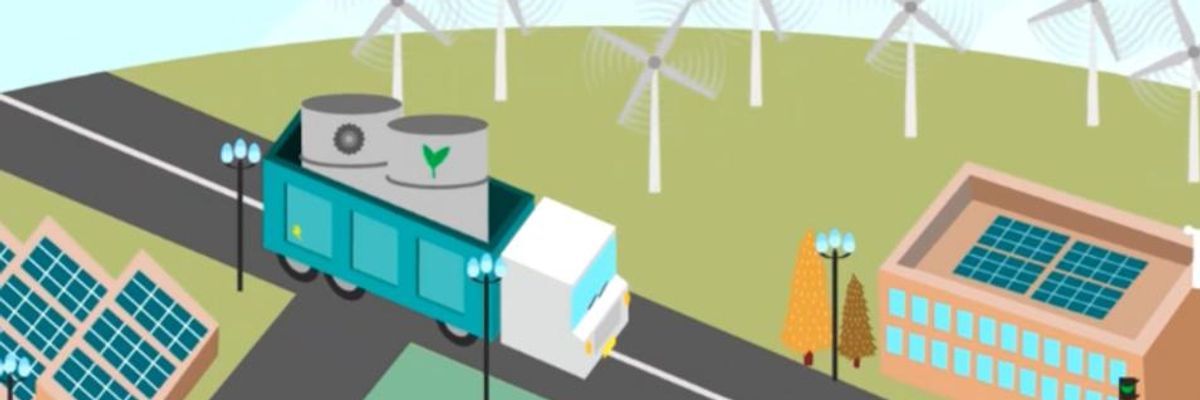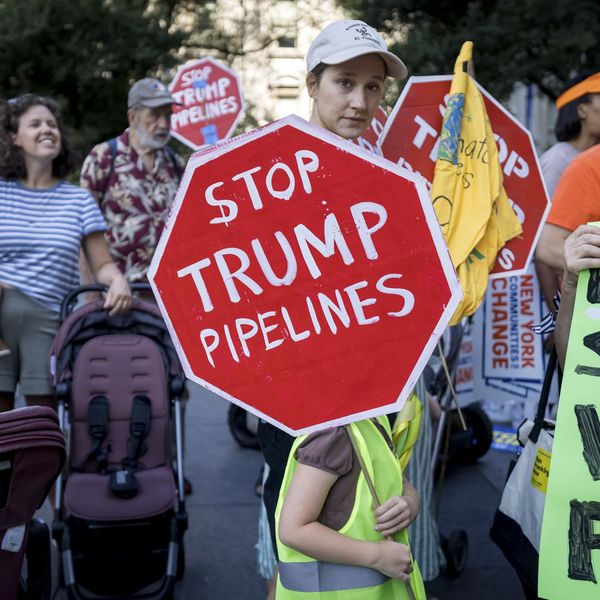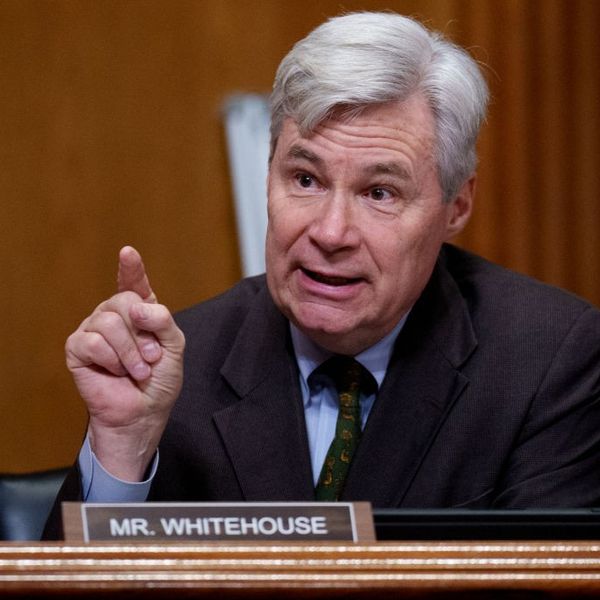
"The next wave of infrastructure spending cannot be business as usual," Poole writes. "The Green Stimulus plan offers a necessary framework for getting this right."
Infrastructure and a Green Stimulus: Why We Must Organize Before Congress Acts
Even without a Donald Trump in the White House, we know from past experience what an infrastructure bill coming out of Congress would look like absent overwhelming grassroots pressure.
There are actions that we must insist the federal government do now to help the people and communities that have been devastated by the effects of the COVID-19 epidemic. Then there are actions that we are tempted to do right now because they would seem to be helpful--but will deeply regret doing if we do them wrong.
When it comes to infrastructure--especially in the throes of climate change--it's more important to do it right than to do it fast.
That's why it was encouraging to hear House Speaker Nancy Pelosi late last week put the brakes on a push for a massive infrastructure bill through Congress. A rushed bill is more likely to perpetuate policies that have been bad for years and will prove worse in the future, such as overemphasizing highway construction and underfunding public transportation, just to name one.
Instead, those of us who care passionately about putting people back to work rebuilding America should be using the next few weeks to build a broad, powerful coalition for a "Green Stimulus." It will take a massive, multi-issue, multistakeholder coalition to change the traditional trajectory of infrastructure policymaking in Congress.
"A Green Stimulus to Rebuild Our Economy" was released in late March by 11 leading experts and activists in the climate movement. (Disclosure: One of the authors is Johanna Bozuwa, a colleague at The Democracy Collaborative.) It outlines a $2 trillion plan that would promote the goals of putting millions of people back to work in critical rebuilding efforts, transition quickly and equitably to a fossil-fuel-free economy, and putting people in control of a larger share of the economy.
Even without a Donald Trump in the White House, we know from past experience what an infrastructure bill coming out of Congress would look like absent overwhelming grassroots pressure. Simply put, a disproportionate share will be spent on perpetuating fossil-fuel dependency in a regulatory framework designed to bulldoze over community concerns about environmental and economic effects.
Powerful lobbies for the construction, shipping, automotive and airline industries have deep channels of influence in Congress, particularly with the pivotal House Transportation and Infrastructure Committee, once of the largest committees in Congress and one in which members are anxious to greenlight actions that will lead to ribbon-cutting ceremonies in their districts. The transportation industry alone spent $68 million in congressional campaign contributions in 2018 and more than $260 million in lobbying in 2019, according to Open Secrets. It's a big reason why public transportation options get slightly less than one dollar for every four dollars the federal government spends on highways. It's also a big reason why the regulatory emphasis has been to move projects quickly and cheaply (for the private contractors involved) than to act in ways that protect the environment, promote sustainability and safeguard the needs of affected communities.
Add to that the woefully inadequate and often poorly spent funding on other forms of public infrastructure--from water systems to public buildings and facilities--and the picture becomes one of a series of missed opportunities to use public dollars to build a more sustainable, resilient and equitable backbone for the economy.
The next wave of infrastructure spending cannot be business as usual. The Green Stimulus plan offers a necessary framework for getting this right. That framework includes:
- Creating millions of new family-sustaining, career-track green jobs in clean energy expansion, including in such areas as building retrofits, sustainable homebuilding, and electric transportation
- Targeting investments in frontline communities left behind by previous economic expansions and in line to be hit hardest by climate change
- Expanding public and employee ownership, either through existing public agencies, by taking equity stakes in companies receiving substantial direct investment, or by conditioning public stimulus support on expanded worker or cooperative ownership
- Rapidly cutting carbon pollution consistent with limiting global warming increases to 1.5 degrees Celsius, in a way that protects the salaries, benefits, and retirements of fossil fuel workers
Included in the Green Stimulus plan is one action that organizers can take now to make it the framework for any future infrastructure plan that emerges from Congress. "We can do all the preparatory work now to make green projects 'shovel ready,'" the authors write, through community deliberation and planning work, "done safely through online channels," to "ensure that physical projects can commence as soon as it is feasible to restart major in-person work across the economy."
Communities across the country are still suffering from federal infrastructure spending mistakes made as far back as the 1960s. At a time when we have at most a decade to make massive economic and lifestyle shifts to avoid a cataclysm that will be more devastating than today's COVID-19 epidemic, we simply cannot let the inertia from the past drive the future.
An Urgent Message From Our Co-Founder
Dear Common Dreams reader, The U.S. is on a fast track to authoritarianism like nothing I've ever seen. Meanwhile, corporate news outlets are utterly capitulating to Trump, twisting their coverage to avoid drawing his ire while lining up to stuff cash in his pockets. That's why I believe that Common Dreams is doing the best and most consequential reporting that we've ever done. Our small but mighty team is a progressive reporting powerhouse, covering the news every day that the corporate media never will. Our mission has always been simple: To inform. To inspire. And to ignite change for the common good. Now here's the key piece that I want all our readers to understand: None of this would be possible without your financial support. That's not just some fundraising cliche. It's the absolute and literal truth. We don't accept corporate advertising and never will. We don't have a paywall because we don't think people should be blocked from critical news based on their ability to pay. Everything we do is funded by the donations of readers like you. Will you donate now to help power the nonprofit, independent reporting of Common Dreams? Thank you for being a vital member of our community. Together, we can keep independent journalism alive when it’s needed most. - Craig Brown, Co-founder |
There are actions that we must insist the federal government do now to help the people and communities that have been devastated by the effects of the COVID-19 epidemic. Then there are actions that we are tempted to do right now because they would seem to be helpful--but will deeply regret doing if we do them wrong.
When it comes to infrastructure--especially in the throes of climate change--it's more important to do it right than to do it fast.
That's why it was encouraging to hear House Speaker Nancy Pelosi late last week put the brakes on a push for a massive infrastructure bill through Congress. A rushed bill is more likely to perpetuate policies that have been bad for years and will prove worse in the future, such as overemphasizing highway construction and underfunding public transportation, just to name one.
Instead, those of us who care passionately about putting people back to work rebuilding America should be using the next few weeks to build a broad, powerful coalition for a "Green Stimulus." It will take a massive, multi-issue, multistakeholder coalition to change the traditional trajectory of infrastructure policymaking in Congress.
"A Green Stimulus to Rebuild Our Economy" was released in late March by 11 leading experts and activists in the climate movement. (Disclosure: One of the authors is Johanna Bozuwa, a colleague at The Democracy Collaborative.) It outlines a $2 trillion plan that would promote the goals of putting millions of people back to work in critical rebuilding efforts, transition quickly and equitably to a fossil-fuel-free economy, and putting people in control of a larger share of the economy.
Even without a Donald Trump in the White House, we know from past experience what an infrastructure bill coming out of Congress would look like absent overwhelming grassroots pressure. Simply put, a disproportionate share will be spent on perpetuating fossil-fuel dependency in a regulatory framework designed to bulldoze over community concerns about environmental and economic effects.
Powerful lobbies for the construction, shipping, automotive and airline industries have deep channels of influence in Congress, particularly with the pivotal House Transportation and Infrastructure Committee, once of the largest committees in Congress and one in which members are anxious to greenlight actions that will lead to ribbon-cutting ceremonies in their districts. The transportation industry alone spent $68 million in congressional campaign contributions in 2018 and more than $260 million in lobbying in 2019, according to Open Secrets. It's a big reason why public transportation options get slightly less than one dollar for every four dollars the federal government spends on highways. It's also a big reason why the regulatory emphasis has been to move projects quickly and cheaply (for the private contractors involved) than to act in ways that protect the environment, promote sustainability and safeguard the needs of affected communities.
Add to that the woefully inadequate and often poorly spent funding on other forms of public infrastructure--from water systems to public buildings and facilities--and the picture becomes one of a series of missed opportunities to use public dollars to build a more sustainable, resilient and equitable backbone for the economy.
The next wave of infrastructure spending cannot be business as usual. The Green Stimulus plan offers a necessary framework for getting this right. That framework includes:
- Creating millions of new family-sustaining, career-track green jobs in clean energy expansion, including in such areas as building retrofits, sustainable homebuilding, and electric transportation
- Targeting investments in frontline communities left behind by previous economic expansions and in line to be hit hardest by climate change
- Expanding public and employee ownership, either through existing public agencies, by taking equity stakes in companies receiving substantial direct investment, or by conditioning public stimulus support on expanded worker or cooperative ownership
- Rapidly cutting carbon pollution consistent with limiting global warming increases to 1.5 degrees Celsius, in a way that protects the salaries, benefits, and retirements of fossil fuel workers
Included in the Green Stimulus plan is one action that organizers can take now to make it the framework for any future infrastructure plan that emerges from Congress. "We can do all the preparatory work now to make green projects 'shovel ready,'" the authors write, through community deliberation and planning work, "done safely through online channels," to "ensure that physical projects can commence as soon as it is feasible to restart major in-person work across the economy."
Communities across the country are still suffering from federal infrastructure spending mistakes made as far back as the 1960s. At a time when we have at most a decade to make massive economic and lifestyle shifts to avoid a cataclysm that will be more devastating than today's COVID-19 epidemic, we simply cannot let the inertia from the past drive the future.
There are actions that we must insist the federal government do now to help the people and communities that have been devastated by the effects of the COVID-19 epidemic. Then there are actions that we are tempted to do right now because they would seem to be helpful--but will deeply regret doing if we do them wrong.
When it comes to infrastructure--especially in the throes of climate change--it's more important to do it right than to do it fast.
That's why it was encouraging to hear House Speaker Nancy Pelosi late last week put the brakes on a push for a massive infrastructure bill through Congress. A rushed bill is more likely to perpetuate policies that have been bad for years and will prove worse in the future, such as overemphasizing highway construction and underfunding public transportation, just to name one.
Instead, those of us who care passionately about putting people back to work rebuilding America should be using the next few weeks to build a broad, powerful coalition for a "Green Stimulus." It will take a massive, multi-issue, multistakeholder coalition to change the traditional trajectory of infrastructure policymaking in Congress.
"A Green Stimulus to Rebuild Our Economy" was released in late March by 11 leading experts and activists in the climate movement. (Disclosure: One of the authors is Johanna Bozuwa, a colleague at The Democracy Collaborative.) It outlines a $2 trillion plan that would promote the goals of putting millions of people back to work in critical rebuilding efforts, transition quickly and equitably to a fossil-fuel-free economy, and putting people in control of a larger share of the economy.
Even without a Donald Trump in the White House, we know from past experience what an infrastructure bill coming out of Congress would look like absent overwhelming grassroots pressure. Simply put, a disproportionate share will be spent on perpetuating fossil-fuel dependency in a regulatory framework designed to bulldoze over community concerns about environmental and economic effects.
Powerful lobbies for the construction, shipping, automotive and airline industries have deep channels of influence in Congress, particularly with the pivotal House Transportation and Infrastructure Committee, once of the largest committees in Congress and one in which members are anxious to greenlight actions that will lead to ribbon-cutting ceremonies in their districts. The transportation industry alone spent $68 million in congressional campaign contributions in 2018 and more than $260 million in lobbying in 2019, according to Open Secrets. It's a big reason why public transportation options get slightly less than one dollar for every four dollars the federal government spends on highways. It's also a big reason why the regulatory emphasis has been to move projects quickly and cheaply (for the private contractors involved) than to act in ways that protect the environment, promote sustainability and safeguard the needs of affected communities.
Add to that the woefully inadequate and often poorly spent funding on other forms of public infrastructure--from water systems to public buildings and facilities--and the picture becomes one of a series of missed opportunities to use public dollars to build a more sustainable, resilient and equitable backbone for the economy.
The next wave of infrastructure spending cannot be business as usual. The Green Stimulus plan offers a necessary framework for getting this right. That framework includes:
- Creating millions of new family-sustaining, career-track green jobs in clean energy expansion, including in such areas as building retrofits, sustainable homebuilding, and electric transportation
- Targeting investments in frontline communities left behind by previous economic expansions and in line to be hit hardest by climate change
- Expanding public and employee ownership, either through existing public agencies, by taking equity stakes in companies receiving substantial direct investment, or by conditioning public stimulus support on expanded worker or cooperative ownership
- Rapidly cutting carbon pollution consistent with limiting global warming increases to 1.5 degrees Celsius, in a way that protects the salaries, benefits, and retirements of fossil fuel workers
Included in the Green Stimulus plan is one action that organizers can take now to make it the framework for any future infrastructure plan that emerges from Congress. "We can do all the preparatory work now to make green projects 'shovel ready,'" the authors write, through community deliberation and planning work, "done safely through online channels," to "ensure that physical projects can commence as soon as it is feasible to restart major in-person work across the economy."
Communities across the country are still suffering from federal infrastructure spending mistakes made as far back as the 1960s. At a time when we have at most a decade to make massive economic and lifestyle shifts to avoid a cataclysm that will be more devastating than today's COVID-19 epidemic, we simply cannot let the inertia from the past drive the future.

